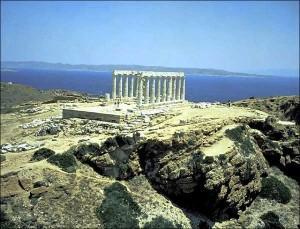Cape Sounion History
For Agamemnon and I had sailed, in friendship, together from Troy: but when we came to the sanctuary of Sounion, the cape south of Athens, Phoebus Apollo killed Menelaus’ helmsman with a painless arrow, while his hands gripped the tiller of the speeding craft. And Phrontis, son of Onetor, had been first among men at steering a ship when gale winds blew. So, though Menelaus was anxious to sail on, he waited to bury his friend, and offered the funeral rites…
 Cape Sounion has existed since prehistoric times. "Sounion Hiron" (sanctuary of Sounion) is mentioned by Homer in his Odyssey, as the place where Menelaos stopped during his return from Troy to bury Phrontis, his helmsman (see text on top, a narration by Nestor). Once more has Cape Sounion received the attention in ancient myths: it is the spot from where Aegeus, king of prehistoric Athens and father to Theseus, misled by the black sails on Theseus’ ship on his way back to Athens, took his fatal plunge into the sea. It had been pre-arranged that white sails would mean that his son would have succeeded in killing Minotaur, the hybrid man-bull, man-eating monster, black sails would signal Perseus’ death. This monster was believed to have been the fruit of intercourse between Minos’ wife, Pasiphae (herself hidden in the hollow of a wooden cow ingeniously provided with all necessary holes, made by Daedalos!), and a magnificent white bull, present of Poseidon to Minos himself. Minotaur was actually killed by Theseus, but the latter forgot to have the white sails hoisted. His father, seeing the black sails from his watch-point at Sounion and persuaded that his beloved son was dead, threw himself down the sheer 197-foot (66 meter) precipice and was drowned in the water of the Sea, which was named "Aegean Sea" after him.
Sounion has been a place of worship and an important sanctuary from Archaic times and lasting through the Hellenistic period. Weathered by the years, and having lost much of its marble adornments, there still remain many of its impressive and powerful columns. While some of the adornments have been forever destroyed, there are some on view at the Archaeological Museum in Athens. Into the marble remains, wishing to share the immortality of the monuments, are chiselled the names of high ranked visitors of the two temples in the past, educated enough to know of their existence and want to visit them, but not to the extent to respect them. We speak of two temples, not one, because at the same site is also situated a Temple to Athena, about 500 meters to the northeast of the one dedicated to Poseidon, where the sanctuary of Athena was established.
In antiquity, towards the end of the 5th century B.C., during the Peloponnesian War, the promontory was heavily fortified, as it was a strategic point of entry to the mainland from the southern waters. A harbor and a ship building workshop were also there, and were fortified as well. This took place after the successful outcome of the Persian Wars, when the sanctuary and the temples, destroyed by Xerxes during his last invasion, were piously resurrected. |
|



